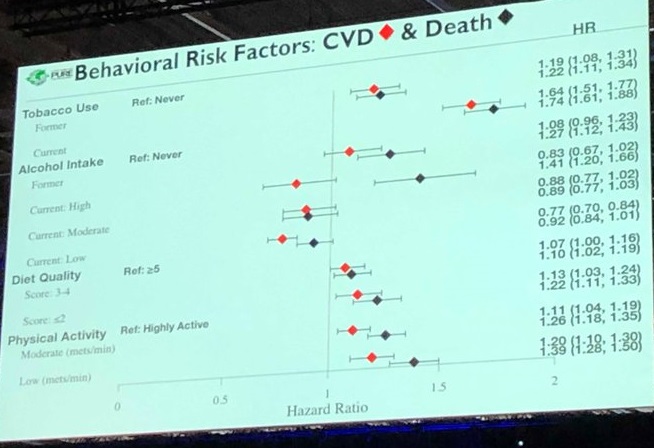Late breaking results from the 21-country PURE study were presented at the ESC Congress 2019 this week. The findings are published in The Lancet.
Nearly seven in ten cases of cardiovascular disease can be explained by risk factors such as high blood pressure, low education, smoking, dyslipidaemia, poor diet, abdominal obesity, strength and physical activity, diabetes, depression, and air pollution. All of these factors can be modified.
The Prospective Urban Rural Epidemiology (PURE) study evaluated multiple risk factors simultaneously in a single study involving people from 900 communities. The study enrolled 155,137 community dwelling adults aged 35 to 70 without prior cardiovascular disease from high, middle, or low-income countries across five continents. Study researchers examined associations of 14 potentially modifiable risk factors with mortality and major cardiovascular disease (cardiovascular death, myocardial infarction, stroke, or heart failure) over a ten-year period.
The 14 risk factors were hypertension, abdominal obesity, primary education level or less, tobacco use, dyslipidaemia, diabetes, household (solid fuel for cooking) and ambient air pollution, low grip strength, low physical activity, poor diet, depression, excessive alcohol, and sodium intake above six grams per day.

The population attributable fraction, which combined information on the prevalence of each risk factor with its associated risk, was used to estimate the proportion of an outcome accounted for by a given factor. Analyses were adjusted for all risk factors, age, sex, and region.
The average age of the population was 50 years and 58% were female. The proportions of participants from high, middle, and low-income countries were 11%, 66%, and 23%, respectively. During the 9.5 years of follow-up, there were 10,234 deaths and 7,980 cases of major cardiovascular disease, of which 3,559 were heart attacks and 3,557 were strokes.
The 13 individual risk factors accounted for about 70% of cardiovascular disease cases. The greatest contributors were hypertension (25.0%), abdominal obesity (8.4%), low education (8.1%), tobacco (6.8%), and dyslipidaemia (6.5%). Hypertension was a larger risk factor for stroke than myocardial infarction. Additionally, ambient air pollution (a community exposure) added to the risk of cardiovascular disease.
The 13 modifiable risk factors accounted for 72% of deaths, with the largest contributors being low education (16.0%), smoking (11.0%), hypertension (10.9%), household pollution (8.4%), poor diet (7.9%), and low grip strength (7.6%).
“The impact of low strength, low education and air pollution on mortality is not widely appreciated,” said principal investigator Professor Salim Yusuf of the Population Health Research Institute, McMaster University, Hamilton, Canada. “Associations with outcomes were generally similar for most risk factors in high, middle, and low-income countries. However, the contribution of some risk factors to cardiovascular disease and death varied according to how common they were in that country – for example smoking, obesity, education, and indoor air pollution from cooking with solid fuel.”
He concluded: “Regardless of where you live, there are several things that can be done to substantially reduce the risk of having a heart attack or a stroke including avoiding smoking, controlling blood pressure and blood cholesterol, being physically active and improving muscle strength, and eating a balanced diet which includes lots of fruits and vegetables, but also a moderate amount of nuts, fish, unprocessed meats and dairy products.”
Source: Dr. Saleem Yusuf's presentation/ESC Congress 2019/The Lancet
Image and slide credit: Dr. Saleem Yusuf
Latest Articles
obesity, high blood pressure, death, cardiovascular events, risk factors, dyslipidaemia
Nearly seven in ten cases of cardiovascular disease can be explained by risk factors such as high blood pressure, low education, smoking, dyslipidaemia, poor diet, abdominal obesity, strength and physical activity, diabetes, depression, and air pollution-



























